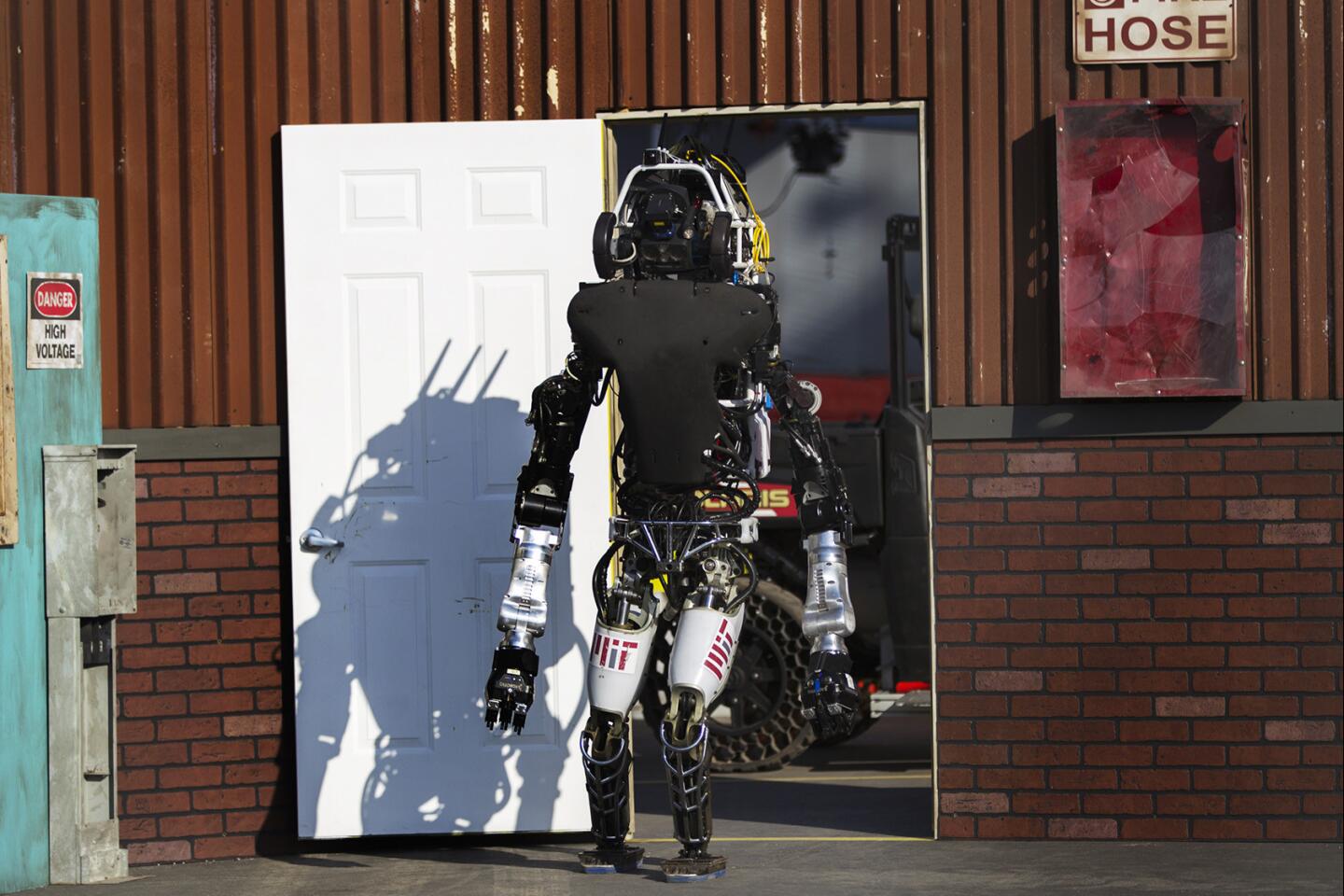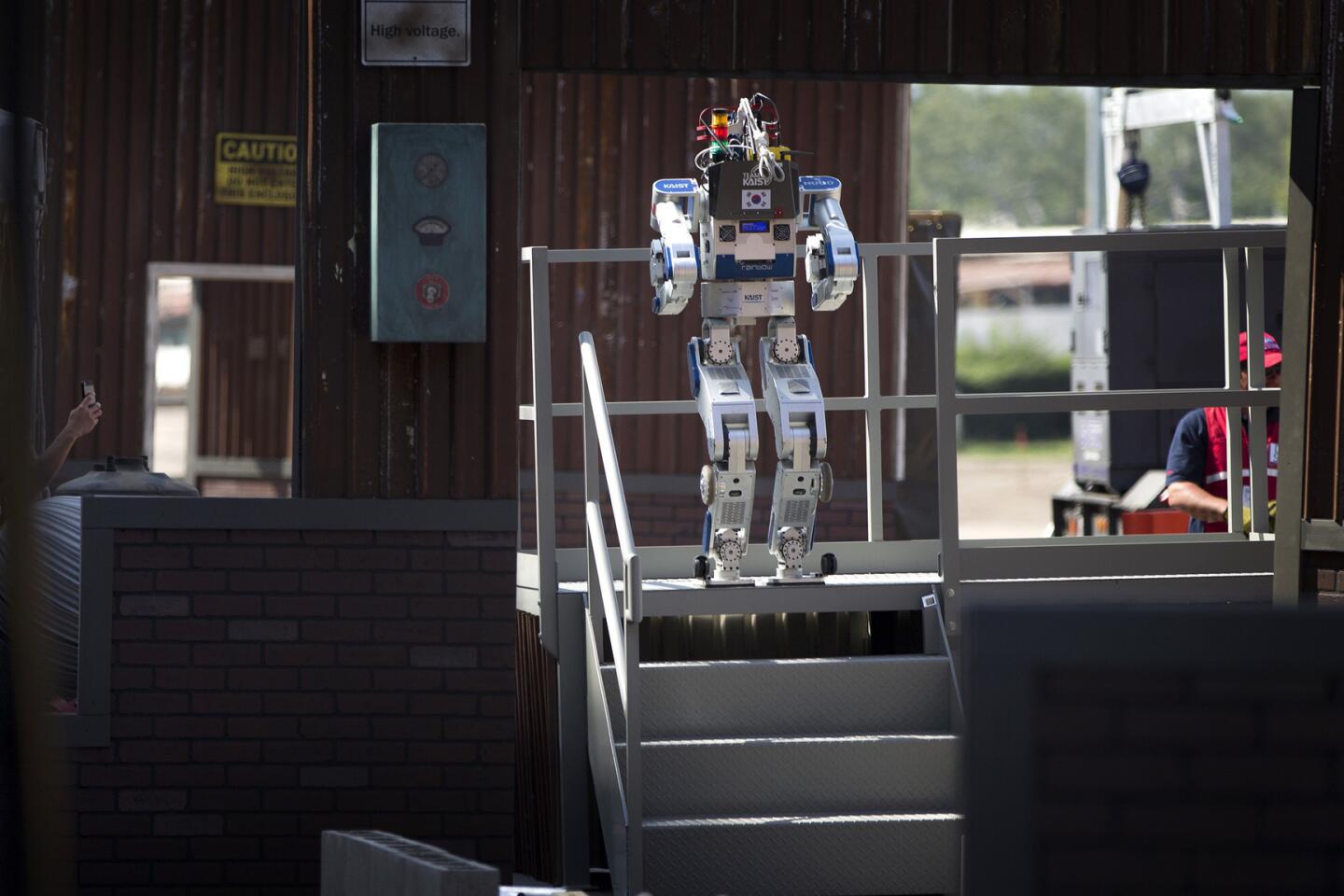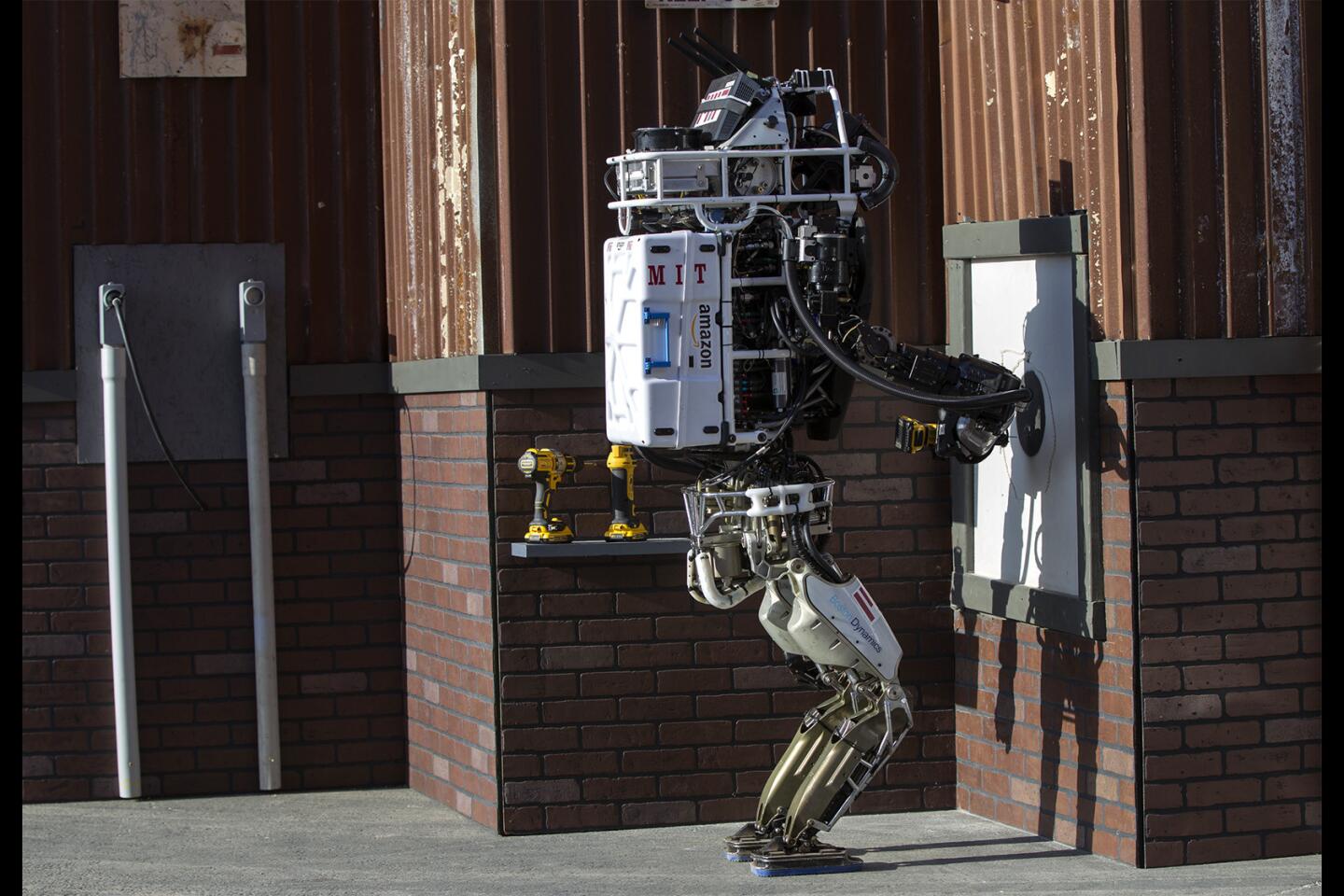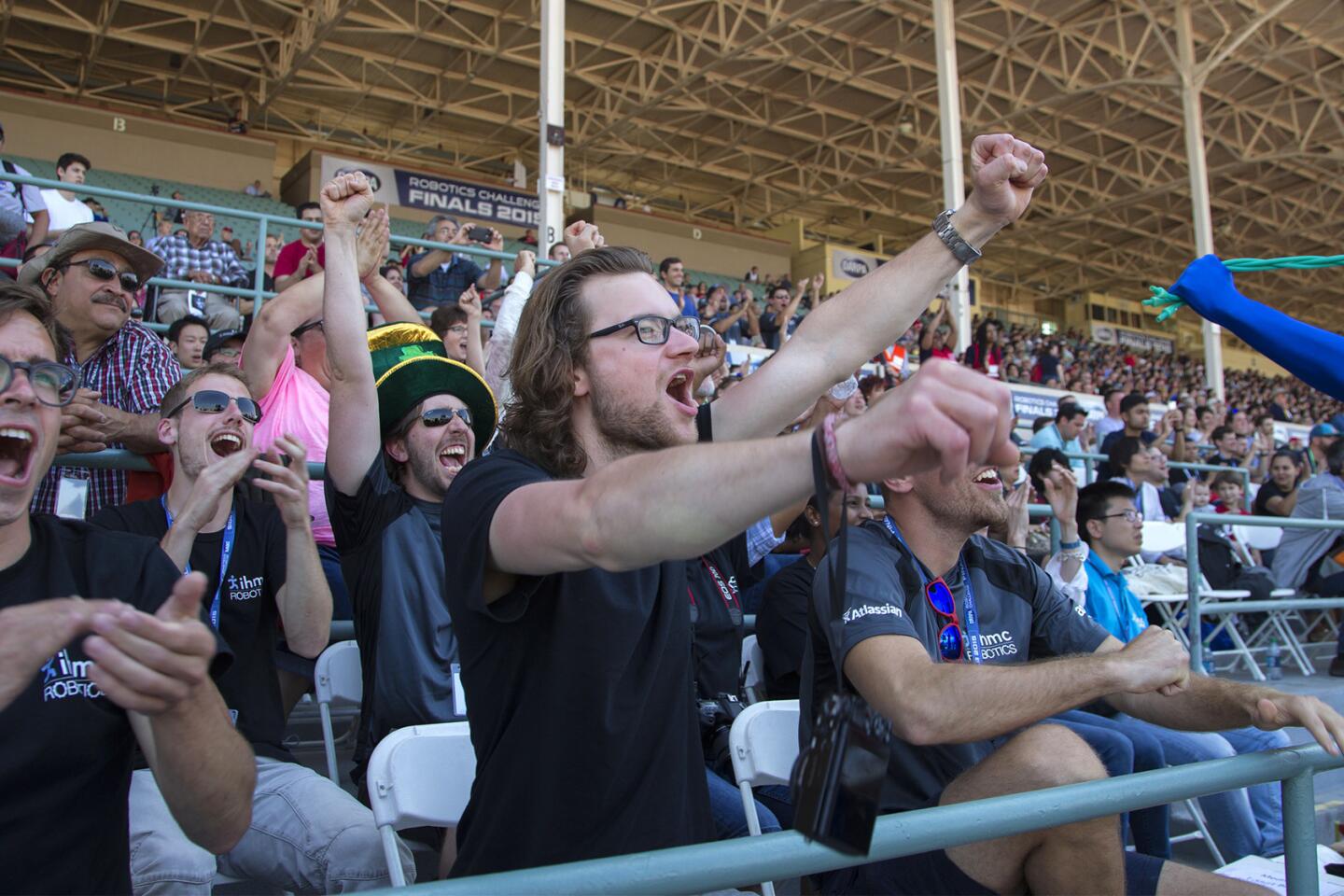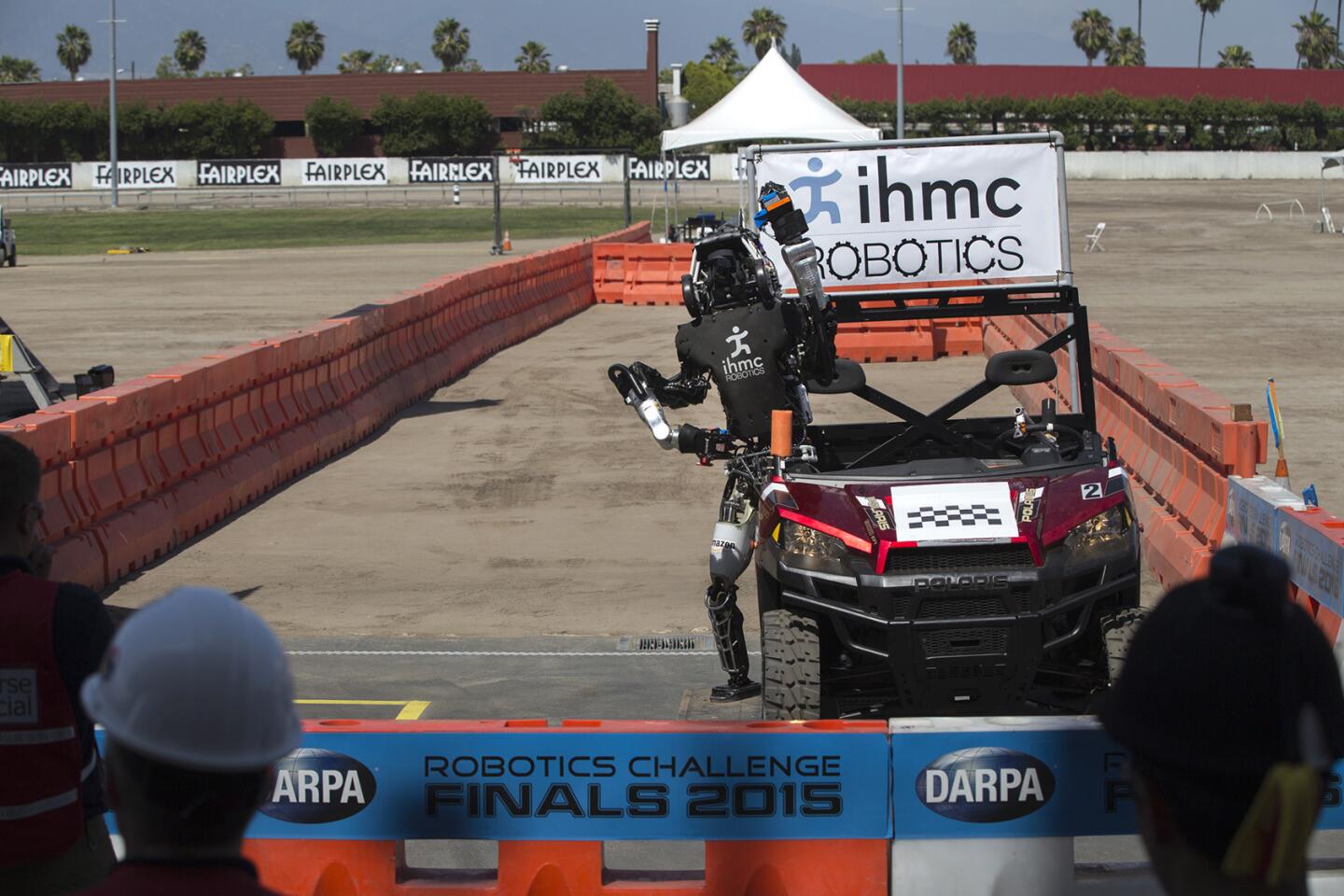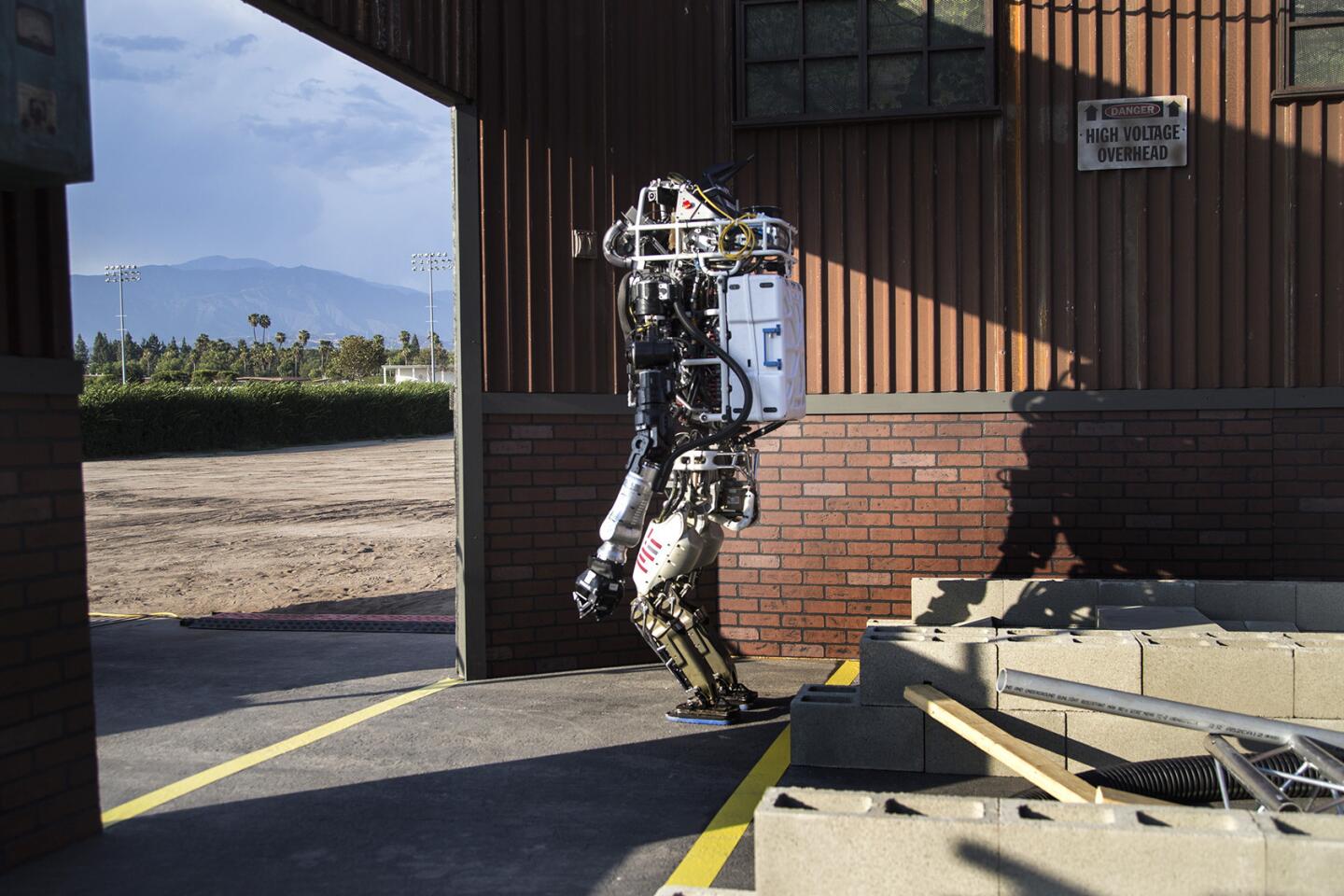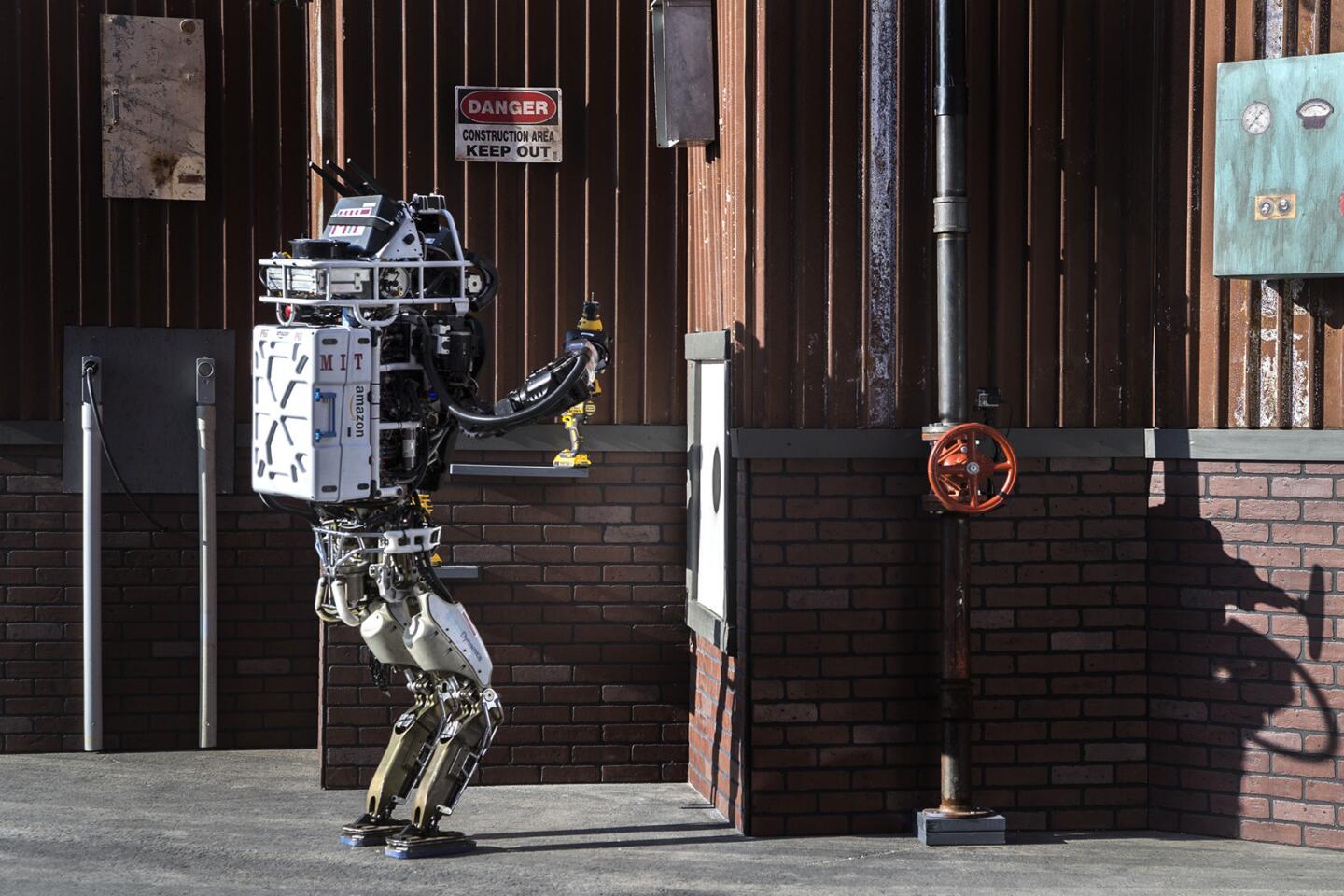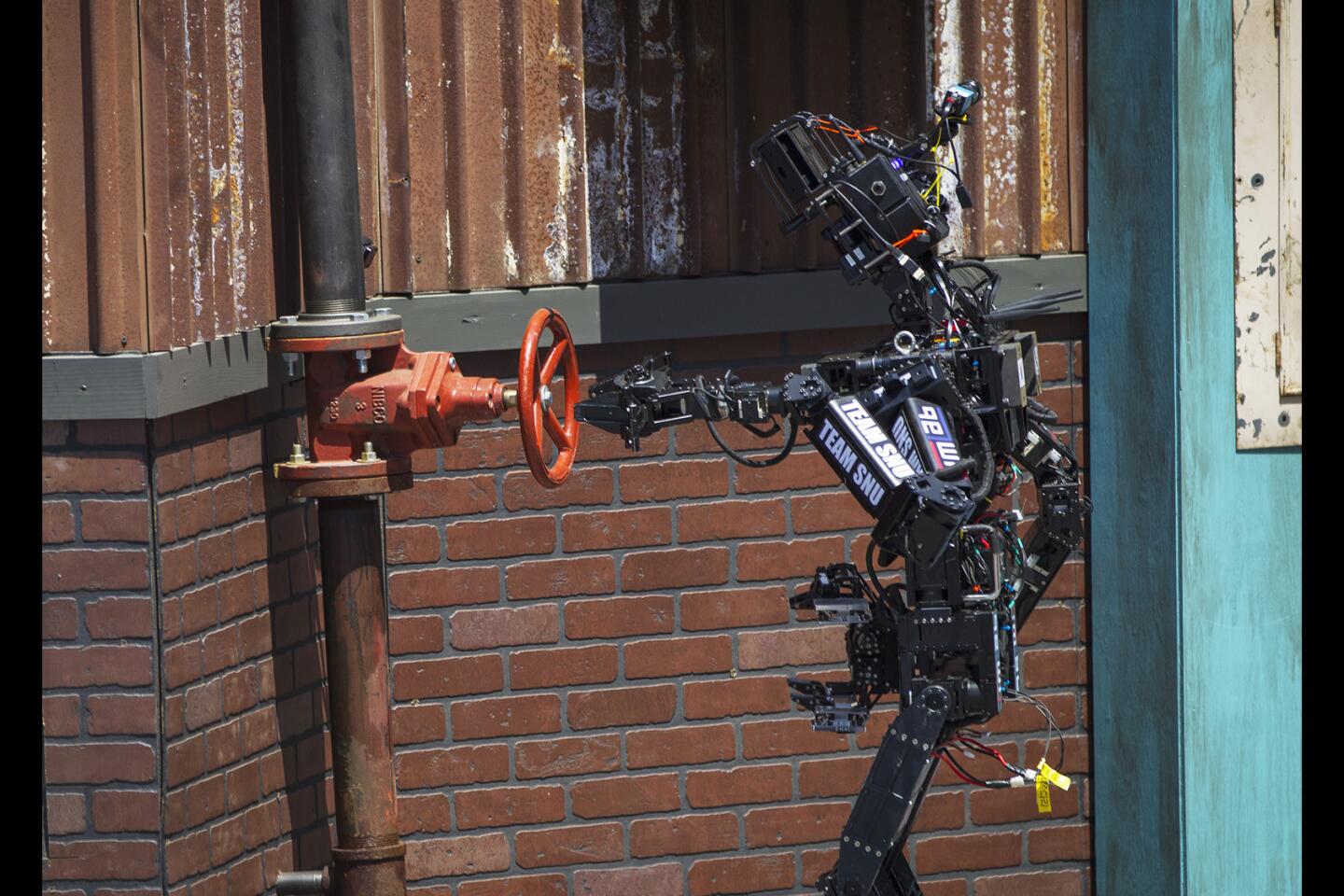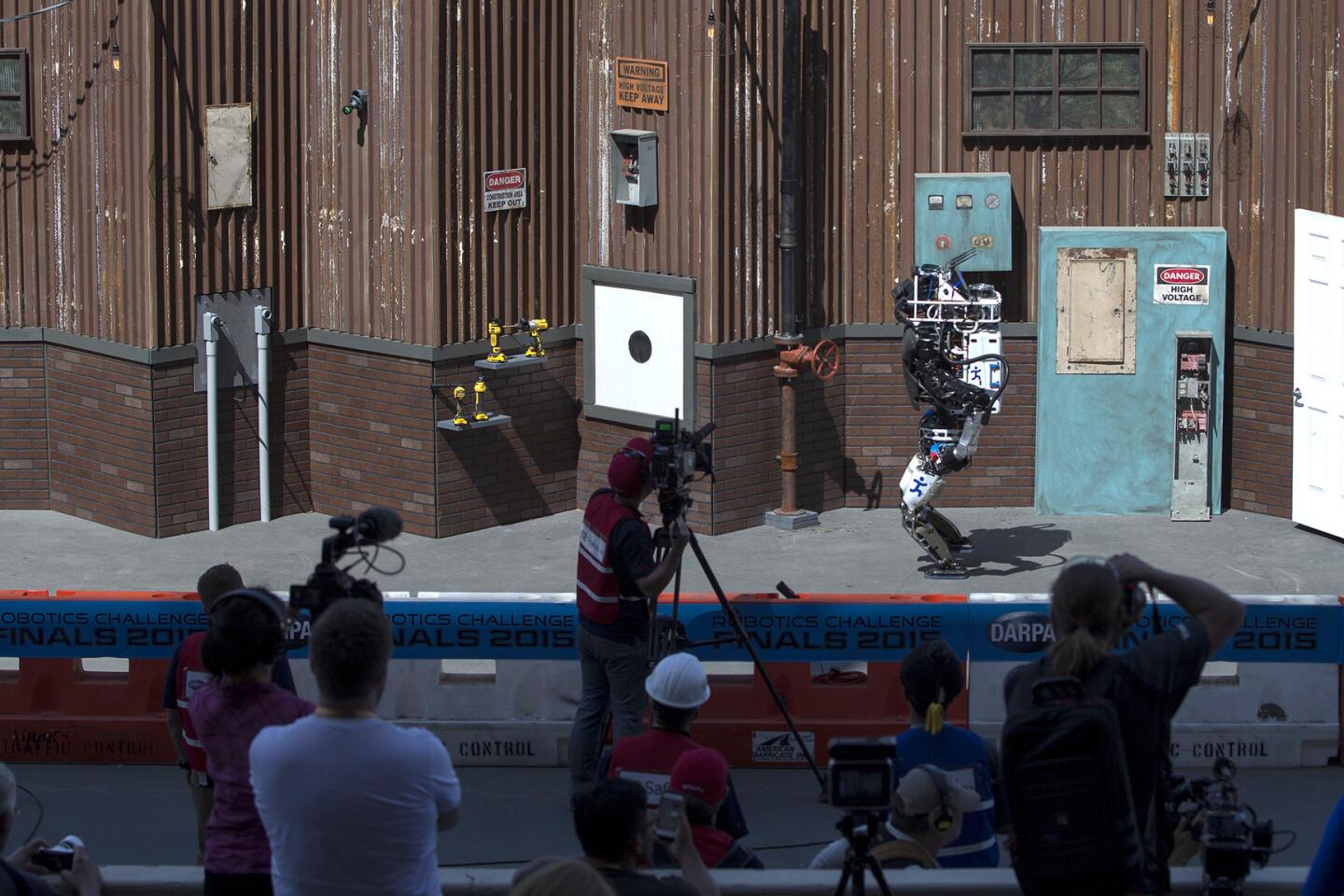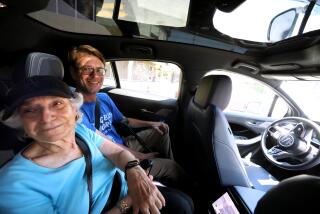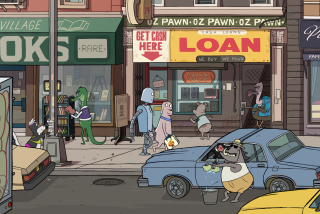Great Read: At DARPA challenge, rescue robots show future of disaster relief
- Share via
In a narrow parking lot, Brett Kennedy and Sisir Karumanchi stand around what looks like a suitcase. But then four limbs extend from its sides, bending and clicking into position. Two spread out like legs and two rise up like arms as the robot goes through several poses, looking for all the world like a Transformer doing yoga.
This is RoboSimian, a prototype rescue robot whose builders at NASA’s Jet Propulsion Laboratory hope can win the $2-million prize at the DARPA Robotics Challenge. The goal: to foster a new generation of rescue robots that could help save lives when the next disaster hits.
Twenty-four teams from around the U.S. and the globe have sent their best and brightest bots to compete in a grueling obstacle course — a robot Olympics, if you will.
The challenge has been three years in the making. Now, a week before the contest in Pomona, the JPL engineers think they are ready — but they’re putting the robot through its paces.
RoboSimian stands in front of a doorway leading to a zigzagging chipboard wall. Along the wall are a valve that must be turned, a high shelf and a low shelf, each holding two power tools.
To get into the “room,” the 275-pound robot sits back on its haunches and carefully wheels through the doorway on its butt.
Inside the laboratory, Kyle Edelberg is staring at a computer screen showing a representation of RoboSimian and what it sees. He can’t walk outside and check on the robot; his senses are limited by RoboSimian’s.
The robot freezes when it reaches for a triangle-shaped pull. It’s hard for the robot to see the thin metal, and hard for the human to pick it out even if RoboSimian does see it.
This is how operating a rescue robot will feel in a disaster zone, Kennedy says. Robots will be sent to perform reconnaissance or fix malfunctioning hardware in ravaged areas that are too dangerous for humans. So being able to understand and work with the robot — and practice with it — is key.
Outside, RoboSimian reaches for a drill on the lower shelf. The bot pushes against the drill to gauge its location, but pushes too far: The drill tips and falls over.
Most of the other robots in the challenge are humanoid — they have a head, a torso, two arms and two legs. But walking on two legs is a major balancing challenge — a gust of wind or a swinging door could knock the robots over.
“The thing that would almost guarantee our winning the program,” Kennedy says, “would be if the Santa Anas kick up.”
::
Across town, engineers at UCLA are also working on their entry into the DARPA challenge. As students pore over papers and fiddle with electronics, professor Dennis Hong shows off two models of their humanoid robot, THOR-RD, one of which sports shocking pink hair.
“We’re trying to literally save the world and save humanity,” Hong says. But “we want to have some fun.”
Hong, who moved from Virginia Tech last year, bounces around the lab space, where the UCLA-University of Pennsylvania team has built a smaller version of a course, much like the one at JPL, to fit indoors.
Hong has worked on several different kinds of robots, some inspired by animals, including a snake and an amoeba robot. He even worked with Kennedy several years ago on a predecessor to RoboSimian named LEMUR.
But for this challenge, Hong has chosen to stick with a humanoid form. After all, he says, animal-inspired robots can each do one thing well — climb poles or perhaps squeeze into hard-to-reach places. That’s useful in specific circumstances during a disaster, but not all of them. Here, the robots will be asked to do a wide variety of human tasks, so a bipedal approach makes sense.
“Robots need to be humanoid for disaster relief, because robots need to drive a car, need to climb steps,” Hong says, though he adds that he would be watching JPL’s performance.
“If they fail, it means, oh, what I said was right,” he says. “And if they indeed do well, it means they’ve proven me wrong.”
::
Gill Pratt, program manager of the DARPA Robotics Challenge, grips the handle of a white door under a yellow warning sign that reads, “CAUTION: HIGH VOLTAGE. DO NOT ENTER THIS ENCLOSURE.”
He pushes on the door, embedded in a wall of faux brick and corrugated metal, to reveal the real obstacle course, sitting in a field in front of the grandstand at the Fairplex in Pomona. Three more identical courses are lined up beside it.
The course is a three-sided stage that’s open to spectators filling the bleachers above. Along the wall, the lanky engineer faces a familiar set of objects: a tall black pipe with an orange valve that can be turned like a steering wheel and a staggered pair of shelves that await power tools. Near the end of the room, a pile of concrete cinder blocks lies in front of the exit to the other side. The robots can choose whether to clamber over the cinder blocks or wrestle their way through debris that will be strewn next to it when the competition starts.
The robots will compete to beat the clock: finish up to eight tasks before an hour runs out. Four robots will compete at a time, each in its own stage on the field, so that spectators can compare their progress.
The idea for this DARPA challenge grew out of the disaster at the Fukushima-Daiichi nuclear power plant in Japan, after a massive earthquake and tsunami in 2011. At one point during the crisis, employees at the nuclear power plant needed to open some valves to release steam to avert an explosion, but could not get close enough, fast enough, because of the massive amounts of radiation.
If robots had been available to perform the tasks, they could have mitigated the disaster, the thinking goes. But the technology doesn’t yet exist. DARPA, or the Defense Advanced Research Projects Agency, is an arm of the Defense Department that seeks to develop these kinds of emerging technologies — and they do so by putting on these high-risk, high-reward contests.
The robots have to drive a car to the door, but the hardest part of the ride is getting out of the vehicle without falling, Pratt says. He goes through the motions of some of the assigned tasks: He turns a valve, mimes drilling through a window where drywall will be placed and climbs over the concrete blocks. But before he completes the course, he gestures at a hole in a wall: a mystery task that none of the teams knows about yet.
Since the semifinals in late 2013, DARPA has made the challenge even harder: The robots can’t operate with power cords — which means they have to have all their heavy batteries on board. And they can’t use safety belays to keep the robots from falling — a problem for many of the two-legged robots, which already have trouble with balance. (This is where the wheeled and four-limbed contestants may have an advantage — they’re inherently stable.)
“In a real disaster, there are no ropes to hold you up,” Pratt says.
As if the tasks weren’t hard enough, Pratt’s team will be shutting down the wireless communications so that the teams will only get about one second’s worth of information for every 30 seconds of competition.
“If you’ve ever been on a really bad cellphone call ... it’s like that, but 10 times worse,” Pratt says.
There’s a very good reason for doing this, he points out. In a disaster zone, the networks get overloaded. Because of radiation shielding, communication goes down. So it’s very hard to directly control a robot when you can only send commands and receive vital information in broken bits and pieces.
The RoboSimian team is setting up in a cavernous garage near the obstacle course. As other teams unpack robots, lug in couches and start setting up mock obstacle courses, Kennedy’s group seems relaxed. He shrugs at the surrounding chaos, sipping a Pellegrino soda while RoboSimian stands behind him.
A few members of the MIT team come over to greet Karumanchi, who used to work with them — and they hand him a team T-shirt emblazoned with a robot riding a dragon.
“They dared me to wear this with the JPL hat,” he says, smiling. “I told them I’d wear it once we beat them.”
::
The two-day competition gives each team two chances to earn a high score. On the first day, RoboSimian is one of the top performers, as is CHIMP, the other ape-like robot in the running. The behemoth built by Carnegie Mellon University quickly becomes a fan favorite on the first day when it does what no other fallen robot has done: It picks itself back up and keeps going, earning roars of approval and the only perfect eight-point score.
On the second day, UCLA’s THOR-RD robot, like many of the other bipedal robots, takes mincing steps toward its target, but falls backward partway between the valve and the drill. It’s out of the running for the big prize.
After its second performance, RoboSimian also falls short, ending up in fifth place.
CHIMP’s high score from the first day helps earn it third place and $500,000; second place and $1 million goes to Running Man from Team IHMC Robotics in Florida. Team KAIST from South Korea takes the $2-million prize after dispatching all eight tasks on Saturday with amazing speed.
As the event is winding down, four-wheeled Momaro, from Team NimbRo Rescue in Germany, struggles through the course. There’s no chance the bright orange robot will win, but still it pushes on alone through the debris with one wheel askew, to cheers from the crowd.
But the stairs still stretch in front of the robot. Momaro’s spinning head seems to ponder whether to attempt this final task. Then, very slowly, it turns its torso to the grandstand, raises an arm and jiggles it.
It takes a moment for the crowd to realize what’s happening, and then the applause grows to a crescendo: The robot has tried its best. Now, it is waving goodbye.
Twitter: @aminawrite
